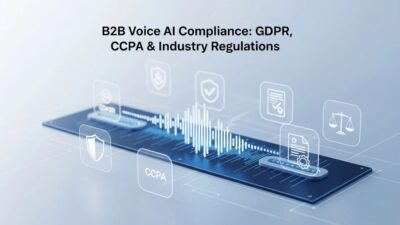TL;DR
Voice bot recording laws determine the legal boundaries for capturing AI-powered customer interactions. Businesses must understand complex regulations before implementing call recording systems. Recording violations can result in severe penalties and lawsuits. Your organization needs comprehensive compliance strategies.
Table of Contents
Federal and state regulations create overlapping requirements. The legal landscape varies significantly across jurisdictions. International operations face additional complexity. Professional legal guidance is essential for proper implementation.
Understanding AI Call Recording Compliance Fundamentals
AI call recording compliance requires careful attention to consent requirements and privacy protections. Technology advances have outpaced regulatory frameworks. Businesses operate in uncertain legal territory. Your compliance team must stay current with evolving requirements.
Recording laws generally fall into two categories: one-party consent and two-party consent states. Federal wiretapping laws provide baseline protections. State regulations often impose stricter requirements. International calls introduce additional complications.
Federal Recording Regulations
The Federal Wiretapping Act governs electronic communications interception. Title III requires consent from at least one party. Business calls may have different requirements. Your organization must understand federal baseline protections.
The Electronic Communications Privacy Act updates federal protections. Modern technology applications face regulatory scrutiny. Voice over IP systems require special consideration. Your legal team should review current federal requirements.
State-Level Variations
State recording laws create a complex patchwork of requirements. California requires consent from all parties. New York permits one-party consent recording. Your system must comply with the strictest applicable standard.
Multi-state operations face significant compliance challenges. Call routing may cross multiple jurisdictions. Recording systems need geographic awareness. Your technology must adapt to varying state requirements.
Key Automated Call Documentation Requirements
Automated call documentation serves multiple business purposes while requiring careful legal compliance. Quality assurance programs rely on recorded interactions. Training materials benefit from real customer examples. Legal protection often requires detailed documentation.
Recording systems must capture specific information types. Audio quality standards ensure usability. Metadata requirements vary by industry. Your organization needs comprehensive documentation strategies.
Business Justification Standards
Legitimate business purposes justify most recording activities. Customer service quality improvement programs qualify. Training and coaching applications receive protection. Your organization must document valid business reasons.
Security monitoring may require call recording. Fraud prevention systems benefit from audio documentation. Compliance monitoring often mandates recording. Your business case must support recording decisions.
Technical Implementation Requirements
Recording systems need robust technical infrastructure. Audio quality must meet industry standards. Storage systems require secure access controls. Your IT team must implement proper safeguards.
Real-time processing capabilities enable immediate analysis. Cloud storage provides scalability advantages. Backup systems prevent data loss. Your technology choices impact compliance requirements.
One-Party vs Two-Party Consent States
Understanding consent requirements is crucial for voice bot recording laws compliance. One-party consent states allow recording with single participant knowledge. Two-party consent jurisdictions require all parties’ agreement. Your system must identify applicable requirements.
Federal law permits one-party consent recording. State laws may impose stricter standards. The most restrictive applicable law governs. Your compliance approach must address all relevant jurisdictions.
One-Party Consent Jurisdictions
Most states follow one-party consent principles. Business representatives can consent for their organizations. Customer notification may still be required. Your recording practices must respect applicable standards.
One-party consent simplifies compliance requirements. Training programs can use recorded examples. Quality assurance benefits from comprehensive documentation. Your organization enjoys greater operational flexibility.
Two-Party Consent Requirements
Eleven states require all-party consent for recording. California leads strict privacy protections. Connecticut imposes criminal penalties for violations. Your system must obtain explicit consent.
Two-party consent states include:
- California
- Connecticut
- Florida
- Illinois
- Maryland
- Massachusetts
- Montana
- Nevada
- New Hampshire
- Pennsylvania
- Washington
International Recording Considerations
Cross-border operations introduce complex regulatory requirements. European GDPR regulations impact data handling. Canadian privacy laws parallel but differ from US standards. Your organization must understand international obligations.
Voice bot recording laws vary significantly between countries. Some jurisdictions prohibit recording entirely. Others require explicit written consent. Your global operations need localized compliance strategies.
GDPR Impact on Recording
European data protection regulations impose strict requirements. Explicit consent is mandatory for recording. Data retention periods face legal limitations. Your organization must implement comprehensive safeguards.
Right to erasure applies to recorded conversations. Data portability requirements affect storage systems. Privacy by design principles guide implementation. Your technical architecture must support GDPR compliance.
Other International Frameworks
Canada’s Personal Information Protection Act governs recording activities. Australia’s Privacy Act imposes notification requirements. Asian markets have varying regulatory approaches. Your international expansion requires local expertise.
Cross-border data transfers face additional restrictions. Storage location requirements may apply. Processing activities need documented purposes. Your global architecture must address all applicable requirements.
Industry-Specific Recording Regulations
Healthcare organizations face HIPAA compliance requirements. Financial services must follow banking regulations. Government contractors encounter unique obligations. Your industry may have specialized requirements.
AI call recording compliance varies significantly between sectors. Some industries mandate recording for regulatory purposes. Others prohibit recording sensitive information. Your compliance approach must reflect industry standards.
Healthcare Recording Requirements
HIPAA regulations govern healthcare recording activities. Patient consent requirements are strictly enforced. Protected health information needs special handling. Your healthcare recordings must meet privacy standards.
Medical necessity justifies most healthcare recording. Quality assurance programs receive regulatory support. Patient safety initiatives benefit from documentation. Your healthcare organization must balance access and protection.
Financial Services Compliance
Banking regulations often require call recording. Consumer protection laws impose disclosure requirements. Investment advisory services face strict documentation needs. Your financial organization must maintain comprehensive records.
Dodd-Frank Act provisions impact recording practices. Consumer Financial Protection Bureau enforcement affects requirements. State banking regulations add complexity. Your financial compliance must address all applicable requirements.
Technical Implementation Best Practices
Secure recording systems protect sensitive information. Encryption requirements vary by jurisdiction. Access controls limit unauthorized use. Your technical implementation must prioritize security.
Automated call documentation systems need robust architecture. Scalability requirements support business growth. Integration capabilities connect existing systems. Your technology choices impact long-term success.
Storage and Retention Policies
Data retention periods vary by industry and jurisdiction. Some regulations require minimum retention periods. Others mandate maximum storage durations. Your policies must balance requirements and business needs.
Secure storage prevents unauthorized access. Backup systems protect against data loss. Archive capabilities support long-term retention. Your storage architecture must meet all applicable requirements.
Access Control Systems
Role-based access limits recording availability. Audit trails track system usage. Authentication requirements protect sensitive data. Your access controls must prevent unauthorized use.
Supervisor access enables quality monitoring. Compliance teams need review capabilities. IT administrators require system management access. Your access model must support operational needs.
Consent Notification Procedures
Clear notification protects your organization from liability. Standardized language ensures consistent messaging. Timing requirements vary by jurisdiction. Your notification procedures must meet all applicable standards.
Recording notifications should occur at call beginning. Clear language explains recording purposes. Opt-out options may be required. Your notification system must function reliably.
Verbal Notification Scripts
Standardized scripts ensure consistent notification. Legal review validates language compliance. Agent training reinforces proper procedures. Your verbal notifications must meet regulatory requirements.
Professional recording messages provide clear information. Business identification is typically required. Contact information should be accessible. Your automated messages must comply with applicable standards.
Written Consent Forms
Some jurisdictions require written consent documentation. Electronic signatures may satisfy requirements. Consent forms need specific language elements. Your written procedures must meet legal standards.
Consent documentation should be easily accessible. Storage systems must maintain records securely. Retention periods vary by jurisdiction. Your documentation system must support compliance requirements.
Quality Assurance and Training Applications
Recorded calls provide valuable training materials. New employee orientation benefits from real examples. Coaching sessions use actual customer interactions. Your training programs can leverage recorded content.
Quality assurance programs rely on recorded interactions. Performance evaluation becomes more objective. Customer service standards receive consistent enforcement. Your quality initiatives benefit from comprehensive documentation.
Training Program Development
Recorded calls illustrate best practices effectively. Common scenarios receive detailed documentation. Problem resolution techniques become teachable. Your training materials gain authenticity through real examples.
Role-playing exercises use recorded foundations. Simulation training incorporates actual interactions. Skill development programs benefit from practical examples. Your training effectiveness improves through recorded content.
Performance Monitoring
Supervisory review becomes more comprehensive. Agent performance evaluation gains objectivity. Customer satisfaction correlation improves understanding. Your management insights benefit from recorded interactions.
Coaching opportunities emerge from recorded reviews. Individual development plans use specific examples. Team performance trends become visible. Your organizational improvement accelerates through systematic review.
Legal Defense and Documentation
Recorded calls provide essential legal protection. Dispute resolution benefits from accurate documentation. Customer complaint investigations use recorded evidence. Your legal defense improves through comprehensive recording.
Regulatory inquiries often require recorded proof. Compliance audits benefit from detailed documentation. Legal proceedings may demand recorded evidence. Your organization gains protection through systematic recording.
Dispute Resolution
Customer complaints receive objective review. Service quality disputes benefit from recorded evidence. Billing disagreements use documented interactions. Your dispute resolution becomes more effective.
Legal proceedings may require recorded testimony. Expert witnesses can review actual interactions. Settlement negotiations benefit from documented facts. Your legal position strengthens through comprehensive recording.
Regulatory Compliance
Industry regulators may require recorded proof. Compliance audits benefit from comprehensive documentation. Enforcement actions use recorded evidence. Your regulatory relationships improve through systematic recording.
Internal compliance monitoring uses recorded interactions. Policy adherence becomes measurable. Training effectiveness receives objective evaluation. Your compliance programs benefit from recorded documentation.
Data Security and Privacy Protection
Recorded calls contain sensitive personal information. Encryption requirements protect data integrity. Access controls prevent unauthorized disclosure. Your security measures must meet industry standards.
Privacy protection requires comprehensive safeguards. Data minimization principles guide retention decisions. Purpose limitation restricts use cases. Your privacy program must address all applicable requirements.
Encryption Requirements
Data encryption protects recorded information. Transmission security prevents interception. Storage encryption secures archived content. Your encryption strategy must meet current standards.
End-to-end encryption provides maximum protection. Key management systems secure access controls. Regular security audits validate protection effectiveness. Your encryption implementation must address all vulnerabilities.
Access Monitoring
Audit trails track all system access. User authentication prevents unauthorized use. Activity logging documents system usage. Your monitoring systems must detect security incidents.
Real-time alerts notify security teams. Suspicious activity triggers immediate investigation. Regular access reviews validate user permissions. Your security monitoring must prevent unauthorized access.
Cost-Benefit Analysis of Recording Systems
Recording system investments require careful financial analysis. Technology costs include hardware and software. Operational expenses cover storage and maintenance. Your financial planning must address all system costs.
Business benefits justify recording investments. Legal protection prevents costly disputes. Quality improvement enhances customer satisfaction. Your return on investment calculation must consider all benefits.
Implementation Costs
Initial system setup requires significant investment. Hardware purchases support recording infrastructure. Software licensing provides operational capabilities. Your budget must address all implementation requirements.
Ongoing operational costs include storage and maintenance. Staff training requires time and resources. System updates need regular investment. Your operational budget must support sustained recording activities.
Return on Investment
Legal protection benefits exceed implementation costs. Customer satisfaction improvements drive revenue growth. Operational efficiency gains reduce costs. Your ROI calculation must quantify all benefits.
Risk mitigation provides substantial value. Compliance confidence reduces legal exposure. Business intelligence improves decision-making. Your investment justification must address all value sources.
Common Recording Mistakes to Avoid
Inadequate consent procedures create legal liability. Your notification systems must function reliably. Consent documentation requires proper maintenance. Legal review validates procedural compliance.
Insufficient security measures expose sensitive data. Your access controls must prevent unauthorized use. Encryption requirements protect information integrity. Regular security audits validate protection effectiveness.
Poor retention policies violate regulatory requirements. Your storage systems must meet compliance standards. Data destruction procedures need proper implementation. Legal requirements determine retention periods.
Consent Procedure Failures
Missing consent notifications create legal exposure. Your automated systems must function reliably. Backup procedures address system failures. Regular testing validates notification effectiveness.
Inadequate consent documentation limits legal protection. Your record-keeping systems must maintain compliance. Accessible storage supports regulatory requirements. Proper retention meets legal standards.
Security Implementation Gaps
Weak access controls enable unauthorized use. Your authentication systems must prevent security breaches. Role-based permissions limit information access. Regular reviews validate user permissions.
Insufficient encryption exposes sensitive data. Your security measures must meet industry standards. Data transmission requires protection. Storage security prevents unauthorized access.
Measuring Compliance Success
Key performance indicators track recording compliance effectiveness. Your metrics should cover all regulatory requirements. Consent capture rates indicate system performance. Security incident frequencies demonstrate protection effectiveness.
Compliance audits validate recording practices. Your documentation systems must support regulatory review. Internal assessments identify improvement opportunities. External validation provides independent verification.
Compliance Metrics
Consent notification success rates measure system effectiveness. Your tracking systems must monitor all interactions. Documentation completeness supports regulatory requirements. Performance trends guide improvement initiatives.
Security incident reporting demonstrates protection effectiveness. Your monitoring systems must detect all unauthorized access. Response times indicate security readiness. Prevention measures reduce incident frequency.
Audit Preparation
Comprehensive documentation supports regulatory review. Your record-keeping systems must maintain compliance evidence. Audit trails demonstrate system usage. Regular internal reviews prepare for external audits.
Staff training records validate compliance commitment. Your documentation must prove ongoing education. Procedure updates reflect regulatory changes. Compliance culture measurement guides improvement efforts.
Future Trends in Recording Regulations
Artificial intelligence creates new regulatory challenges. Your systems must adapt to evolving requirements. Machine learning applications face increased scrutiny. Predictive analytics raise privacy concerns.
Regulatory frameworks continue developing. Your compliance strategies must remain flexible. International harmonization may simplify requirements. Technology advances outpace regulatory responses.
Emerging Technologies
Advanced AI capabilities require updated compliance frameworks. Your systems may need enhanced monitoring capabilities. Automated decision-making creates new regulatory considerations. Voice recognition technology raises privacy questions.
Cloud computing introduces new compliance challenges. Your data storage must address jurisdictional requirements. Cross-border processing faces regulatory restrictions. Service provider agreements must address compliance obligations.
Regulatory Evolution
Privacy regulations continue strengthening globally. Your compliance programs must adapt to changing requirements. Consumer protection laws expand recording restrictions. International coordination may harmonize standards.
Industry-specific regulations address unique challenges. Your compliance approach must reflect sector requirements. Technology regulations target AI applications. Business practices must align with evolving standards.
Read More: Voice-Activated Reality Alteration: Change Customer Perception
Conclusion

Voice bot recording laws require comprehensive understanding and systematic compliance. AI call recording compliance demands careful attention to consent requirements and privacy protections. Automated call documentation serves essential business purposes while requiring legal adherence.
Your organization must implement robust recording systems with proper safeguards. Technology solutions streamline compliance requirements. Human oversight remains essential for complex decisions. Regular assessments identify improvement opportunities.
Proactive compliance investment prevents costly violations. Your business benefits from enhanced legal protection. Operational efficiency improves through systematic approaches. Recording excellence supports long-term success.
The regulatory landscape continues evolving rapidly. Your compliance strategies must adapt to changing requirements. Professional guidance ensures continued adherence. Investment in comprehensive frameworks provides essential protection.
Successful recording programs balance business needs with legal requirements. Your organization can operate with confidence. Customer relationships benefit from transparent practices. Regulatory compliance supports sustainable growth.






[…] experiences. The system creates positive first impressions that build lasting relationships. Law practice AI enhances client retention through superior service […]